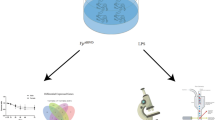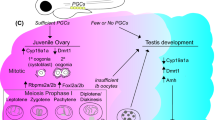Abstract
We explored the use of molecular genetic biomarkers for endocrine disruption in Daphnia magna after the exposure to fenoxycarb (FOC), a model juvenile hormone analog. For this purpose, the mRNA expression patterns of DMRT93B (DMRT, sex determination), cuticle 12 (CUT, molting), and vitellogenin (VTG, embryo development) were determined in D. magna. Furthermore, these results were compared with developmental abnormality and reproduction performance. The fold changes of CUT and VTG mRNA expression showed significant dose–response relationship with FOC exposure. Relative mRNA expressions of DMRT and CUT showed notable changes at as low as 1 ng/l FOC. After chronic exposure FOC significantly delayed the first day of reproduction and decreased the number of young and growth rate even at 10 ng/l FOC. A concentration-dependant trend in reproduction effect was also observed. Developmental abnormality such as poorly developed second antennae and curved or unextended shell spines were observed. These results suggest that the three mRNAs, i.e., DMRT, CUT, and VTG can be used as biomarkers of endocrine disrupting effects in D. magna.



Similar content being viewed by others
References
Burtis KC, Baker BS (1989) Drosophila doublesex gene controls somatic sexual differentiation by producing alternatively spliced mRNAs encoding related sex-specific polypeptides. Cell 56:997–1010
Chang ES, Bruce MJ, Tamone SL (1993) Regulation of crustacean molting: a multi-hormonal system. Am Zool 33:324–329
Cherbas P, Cherbas L (1996) Molecular aspects of ecdysteroid hormone action. In: Gilbert LI, Tata JR, Atkinson BG (eds) Metamorphosis, postembryonic reprogramming of gene expression in amphibian and insect cells. Academic Press, San Diego, pp 175–222
Freeman JA (1990) Molt increment, molt cycle duration, and tissue growth in Palaemonetes pugio Holthuis larvae. J Exp Mar Biol Ecol 143:47–61
Gonzalez P, Dominique Y, Massabuau JC, Boudou A, Bourdineaud JP (2005) Comparative effects of dietary methylmercury on gene expression in liver, skeletal muscle, and brain of the zebrafish (Danio rerio). Environ Sci Technol 39:3972–3980
Gourmelon A, Ahtiainen J (2007) Developing Test Guidelines on invertebrate development and reproduction for the assessment of chemicals, including potential endocrine active substances—the OECD perspective. Ecotoxicology 16:161–167
Ha MH, Choi J (2009) Effects of environmental contaminants on hemoglobin gene expression in Daphnia magna: a potential biomarker for freshwater quality monitoring. Arch Environ Contam Toxicol 57:330–337
Henrich VC, Burns E, Yelverton DP, Christensen E, Weinberger C (2003) Juvenile hormone potentiates ecdysone receptor-dependent transcription in a mammalian cell culture system. Insect Biochem Mol Biol 33:1239–1247
Henry TB, McPherson JT, Rogers ED, Heah TP, Hawkins SA, Layton AC, Sayler GS (2009) Changes in the relative expression pattern of multiple vitellogenin genes in adult male and larval zebrafish exposed to exogenous estrogens. Comp Biochem Physiol A 154:119–126
Hosmer AJ, Warren LW, Ward TJ (1998) Chronic toxicity of pulse-dosed fenoxycarb to Daphnia magna exposed to environmentally realistic concentrations. Environ Toxicol Chem 17:1860–1866
Iguchi T, Watanabe H, Katsu Y (2006) Application of ecotoxicogenomics for studying endocrine disruption in vertebrates and invertebrates. Environ Health Perspect 114:101–105
Iguchi T, Watanabe H, Katsu Y (2007) Toxicogenomics and ecotoxicogenomics for studying endocrine disruption and basic biology. Gen Comp Endocrinol 153:25–29
Jones G, Sharp PA (1997) Ultraspiracle: an invertebrate nuclear receptor for juvenile hormones. PNAS 94:13499–13503
Kato Y, Kobayashi K, Oda S, Colbourn JK, Tatarazako N, Watanabe H, Iguchi T (2008) Molecular cloning and sexually dimorphic expression of DM-domain genes in Daphnia magna. Genomics 91:94–101
Laufer H, Biggers WJ (2001) Unifying concepts learned from methyl farnesoate for invertebrate reproduction and post-embryonic development. Am Zool 41:442–457
Livak KJ, Schmittgen TD (2001) Analysis of relative gene expression data using real-time quantitative PCR and the 2(-delta delta C(T)) method. Methods 25:402–408
McKenney CL (2005) The influence of insect juvenile hormone agonists on metamorphosis and reproduction in estuarine crustaceans. Integr Comp Biol 45:97–105
Mu X, LeBlanc GA (2004a) Cross communication between signaling pathways: Juvenoid hormones modulate ecdysteroid activity in a crustacean. J Exp Zool A 301A:793–801
Mu X, LeBlanc GA (2004b) Synergistic interaction of endocrine-disrupting chemicals: model development using an ecdysone receptor antagonist and a hormone synthesis inhibitor. Environ Toxicol Chem 23:1085–1091
Nagaraju GPC (2007) Is methyl farnesoate a crustacean hormone? Aquaculture 272:39–54
Noji T, Ote M, Takeda M, Mita K, Shimada T, Kawasaki H (2003) Isolation and comparison of different ecdysone-responsive cuticle protein genes in wing discs of Bombyx mori. Insect Biochem Mol Biol 33:671–679
Oda S, Tatarazako N, Watanabe H, Morita M, Iguchi T (2005) Production of male neonates in four cladoceran species exposed to a juvenile hormone analog, fenoxycarb. Chemosphere 60:74–78
Oda S, Tatarazako N, Dorgerloh M, Johnson RD, Ole Kusk K, Leverett D, Marchini S, Nakari T, Williams T, Iguchi T (2007) Strain difference in sensitivity to 3, 4-dichloroaniline and insect growth regulator, fenoxycarb, in Daphnia magna. Ecotoxicol Environ Saf 67:399–405
OECD (2008) Guideline for testing of chemicals, guideline 211. Daphnia magna reproduction test. Organization of Economic Cooperation Development, Paris
Olmstead AW, LeBlanc GA (2000) Effects of endocrine-active chemicals on the development of sex characteristics of Daphnia magna. Environ Toxicol Chem 19:2107–2113
Olmstead AW, LeBlanc GL (2001) Low exposure concentration effects of methoprene on endocrine-regulated processes in the crustacean Daphnia magna. Toxicol Sci 62:268–273
Olmstead AW, LeBlanc GA (2003) Insecticidal juvenile hormone analogs stimulate the production of male offspring in the crustacean Daphnia magna. Environ Health Perspect 111:919–924
Raymond CS, Shamu CE, Shen MM, Seifert KJ, Hirsch B, Hodgkin J, Zarkower D (1998) Evidence for evolutionary conservation of sex-determining genes. Nature 391:691–695
Shen MM, Hodgkin J (1988) mab-3, a gene required for sex-specific yolk protein expression and a male-specific lineage in C. elegans. Cell 54:1019–1031
Snape JR, Maund SJ, Pickford DB, Hutchinson TH (2004) Ecotoxicogenomics: the challenge of integrating genomics into aquatic and terrestrial ecotoxicology. Aquat Toxicol 67:143–154
Soetaert A, van der Ven K, Moens LN, Vandenbrouck T, van Remortel P, De Coen WM (2007) Daphnia magna and ecotoxicogenomics: gene expression profiles of the anti-ecdysteroidal fungicide fenarimol using energy-, molting- and life stage-related cDNA libraries. Chemosphere 67:60–71
Tatarazako N, Oda S, Watanabe H, Morita M, Iguchi T (2003) Juvenile hormone agonists affect the occurrence of male Daphnia. Chemosphere 53:827–833
Tokishita S, Kato Y, Kobayashi T, Nakamura S, Ohta T, Yamagata H (2006a) Organization and repression by juvenile hormone of a vitellogenin gene cluster in the crustacean, Daphnia magna. Biochem Biophys Res Commun 345:362–370
Tokishita S, Kimura S, Mandokora Y, Kato K, Shiga Y, Takahashi Y, Ohta T, Yamagata H (2006b) Tissue-specific expression of a bHLH-PAS protein homologous to ARNT during the development of crustacean Daphnia magna. Gene 376:231–239
USEPA (2002) Methods for measuring the acute toxicity of effluents and receiving waters to freshwater and marine organisms. U.S. Environmental Protection Agency (EPA-821-R-02-012), Washington DC
Van Bohemen CG, Lambert JGD, Goos HJT, Van Oordt PGWJ (1982) Estrone and estradiol participation during exogenous vitellogenesis in the female rainbow trout, Salmo gairdneri. Gen Comp Endocrinol 46:81–92
Willis JH (1981) Juvenile hormone: the status of “status quo”. Am Zool 21:763–773
Acknowledgments
This research was supported by Basic Science Research Program through the National Research Foundation of Korea (NRF) funded by the Ministry of Education, Science and Technology (No. 2010-0017289).
Author information
Authors and Affiliations
Corresponding author
Rights and permissions
About this article
Cite this article
Kim, J., Kim, Y., Lee, S. et al. Determination of mRNA expression of DMRT93B, vitellogenin, and cuticle 12 in Daphnia magna and their biomarker potential for endocrine disruption. Ecotoxicology 20, 1741–1748 (2011). https://doi.org/10.1007/s10646-011-0707-0
Accepted:
Published:
Issue Date:
DOI: https://doi.org/10.1007/s10646-011-0707-0




